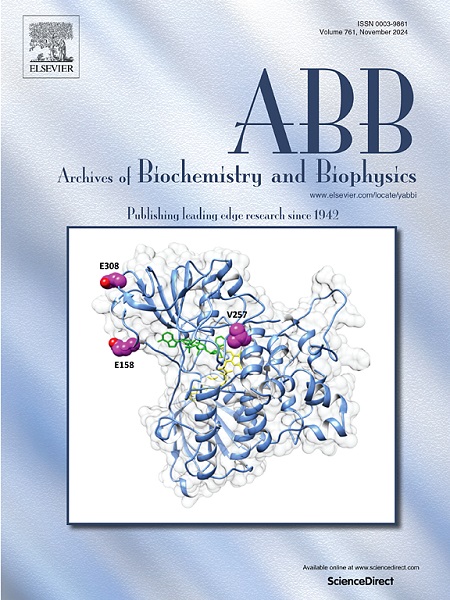Impact of pathogenic mutations on the refolding ability and stability of human mitochondrial Phenylalanyl-tRNA synthetase
IF 3.8
3区 生物学
Q2 BIOCHEMISTRY & MOLECULAR BIOLOGY
引用次数: 0
Abstract
Human mitochondrial phenylalanyl-tRNA synthetase (hmtPheRS) requires partial unfolding for mitochondrial import and subsequent refolding to maintain proper functionality. Mutations in the FARS2 gene, encoding hmtPheRS, cause disorders such as early-onset epileptic encephalopathy and spastic paraplegia. This study was intended to investigate the impact of mutations on hmtPheRS refolding ability, stability, and solubility. We have selected two mutations associated with early-onset epileptic encephalopathy (G309S, D325Y) with severe phenotype and three mutations associated with spastic paraplegia (P136H, D142Y, P361L) with less severe phenotypes. Some of those mutations were reported to have diminished aminoacylation activity. However, the molecular connection of pathogenicity remained elusive for these mutants. We observed that hmtPheRS showed exceptional structural flexibility and refolding ability even at lower pH. Mutations associated with severe phenotypes (G309S, D325Y) exhibited impaired refolding ability and stability, whereas other mutant versions of hmtPheRS linked to hereditary spastic paraplegia (P136H, D142Y, P361L) retained some stability and refolding capacity. Mutants exhibited expansion in hydrodynamic diameter, indicating significant perturbation in the internal architecture. Molecular simulation studies suggested the presence of structural deformities in hmtPheRS mutants at mildly acidic pH. This analysis reveals how mutations affect protein stability and function, which may play a role in mitochondrial disorders. It may act as a probable model for predicting pathogenicity-related mutants.

致病突变对人类线粒体苯丙氨酰-tRNA 合成酶重折叠能力和稳定性的影响
人类线粒体苯丙烯酰trna合成酶(hmtPheRS)需要部分展开线粒体进口和随后的再折叠以维持适当的功能。编码hmtPheRS的FARS2基因突变会导致早发性癫痫性脑病和痉挛性截瘫等疾病。本研究旨在探讨突变对hmtPheRS重折叠能力、稳定性和溶解度的影响。我们选择了两种与严重表型的早发性癫痫性脑病相关的突变(G309S, D325Y)和三种与不严重表型的痉挛性截瘫相关的突变(P136H, D142Y, P361L)。据报道,其中一些突变降低了氨基酰化活性。然而,这些突变体致病性的分子联系仍然难以捉摸。我们观察到hmtPheRS即使在较低的ph值下也表现出特殊的结构灵活性和重折叠能力。与严重表型相关的突变(G309S, D325Y)表现出受损的重折叠能力和稳定性,而与遗传性痉挛性截瘫相关的其他hmtPheRS突变版本(P136H, D142Y, P361L)保留了一些稳定性和重折叠能力。突变体表现出流体动力直径的膨胀,表明内部结构受到了显著的扰动。分子模拟研究表明,在轻度酸性环境下,hmtPheRS突变体中存在结构畸形。该分析揭示了突变如何影响蛋白质的稳定性和功能,这可能在线粒体疾病中发挥作用。它可能作为预测致病性相关突变的可能模型。
本文章由计算机程序翻译,如有差异,请以英文原文为准。
求助全文
约1分钟内获得全文
求助全文
来源期刊

Archives of biochemistry and biophysics
生物-生化与分子生物学
CiteScore
7.40
自引率
0.00%
发文量
245
审稿时长
26 days
期刊介绍:
Archives of Biochemistry and Biophysics publishes quality original articles and reviews in the developing areas of biochemistry and biophysics.
Research Areas Include:
• Enzyme and protein structure, function, regulation. Folding, turnover, and post-translational processing
• Biological oxidations, free radical reactions, redox signaling, oxygenases, P450 reactions
• Signal transduction, receptors, membrane transport, intracellular signals. Cellular and integrated metabolism.
 求助内容:
求助内容: 应助结果提醒方式:
应助结果提醒方式:


